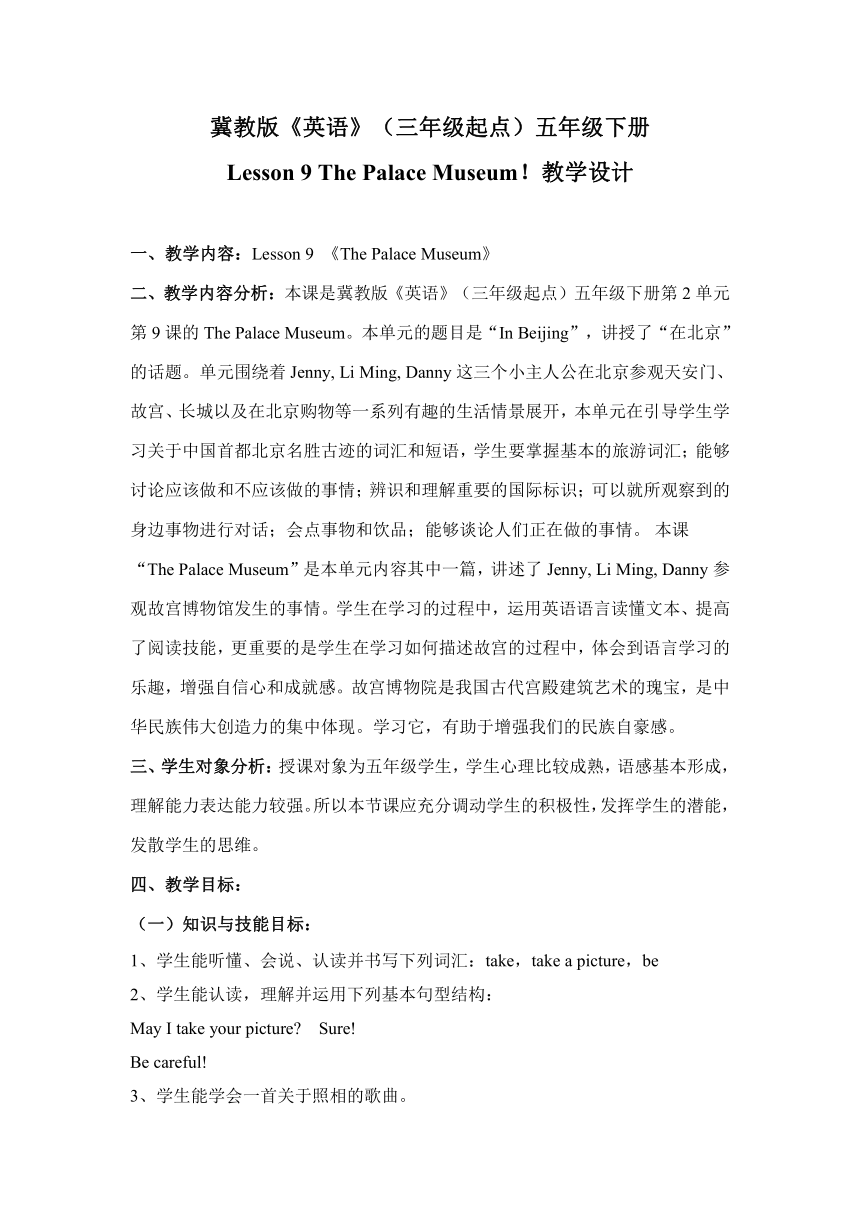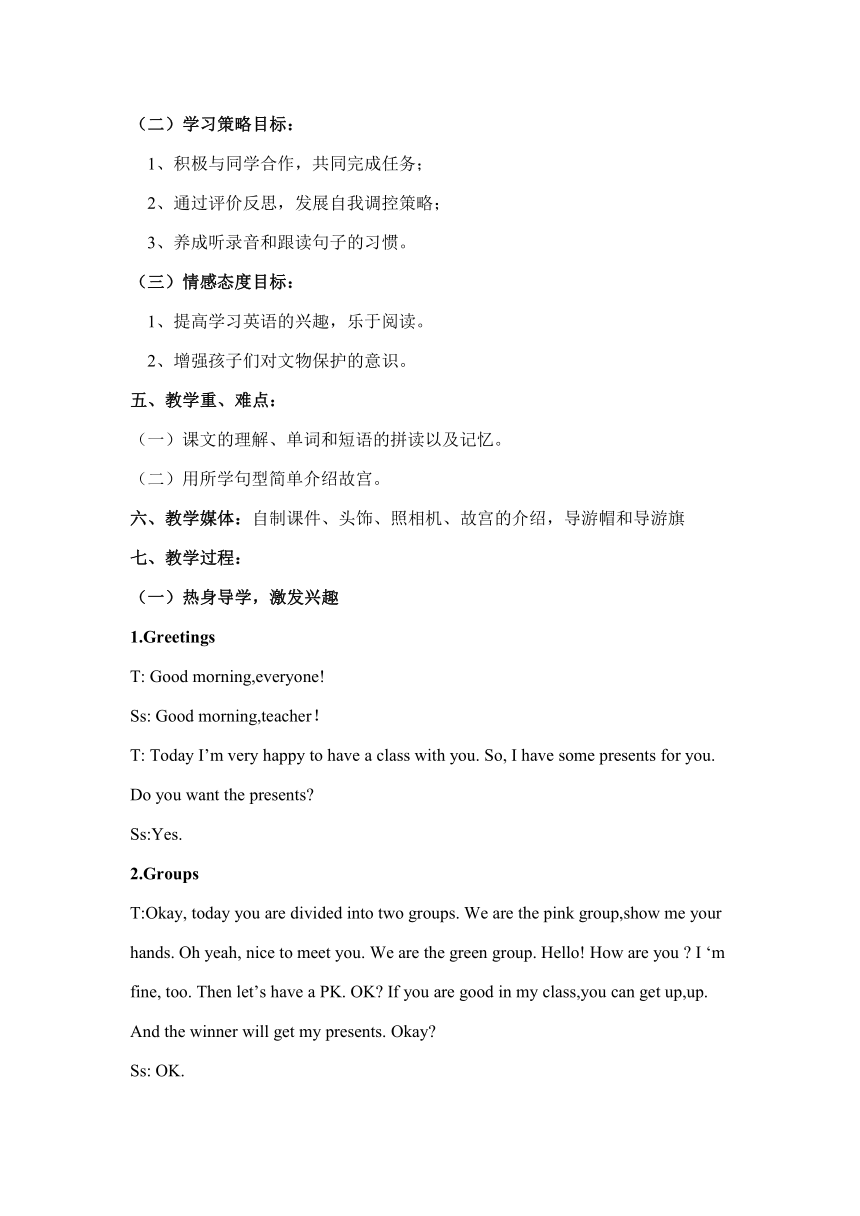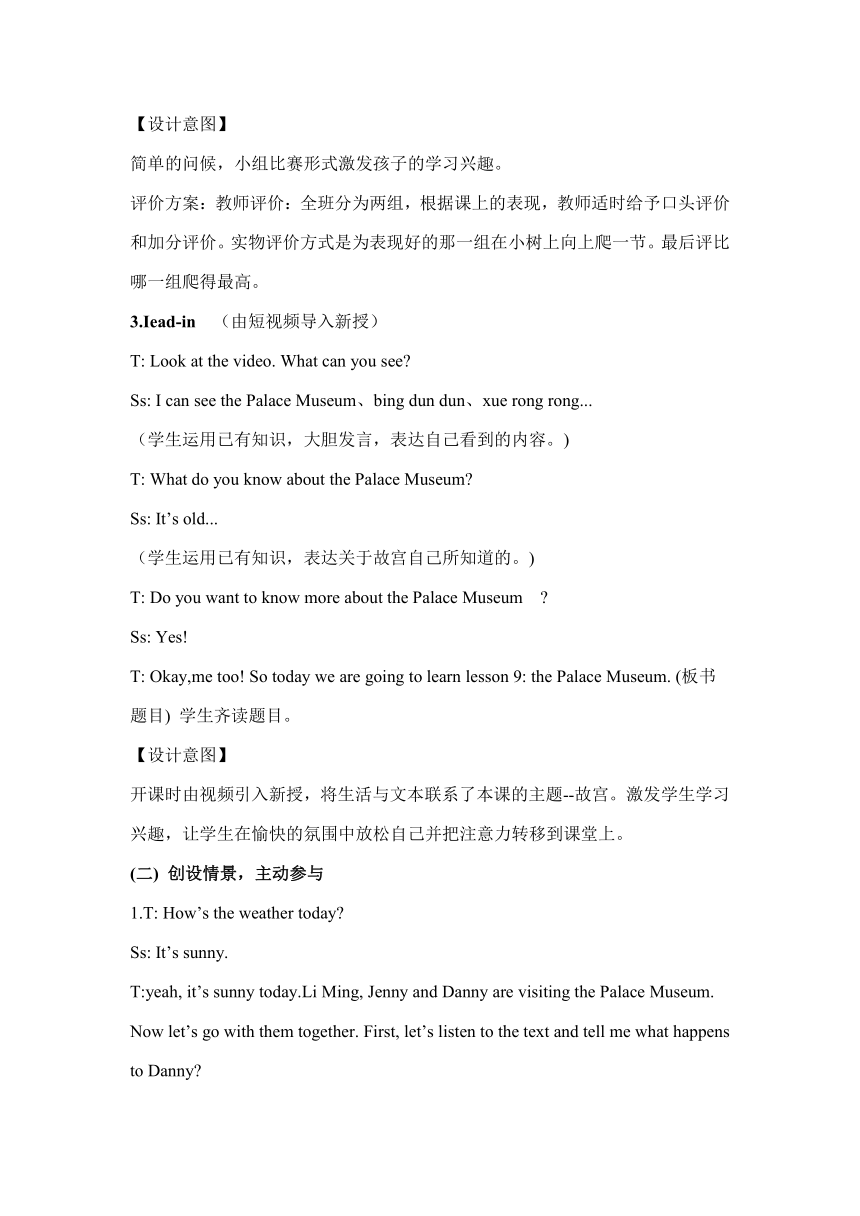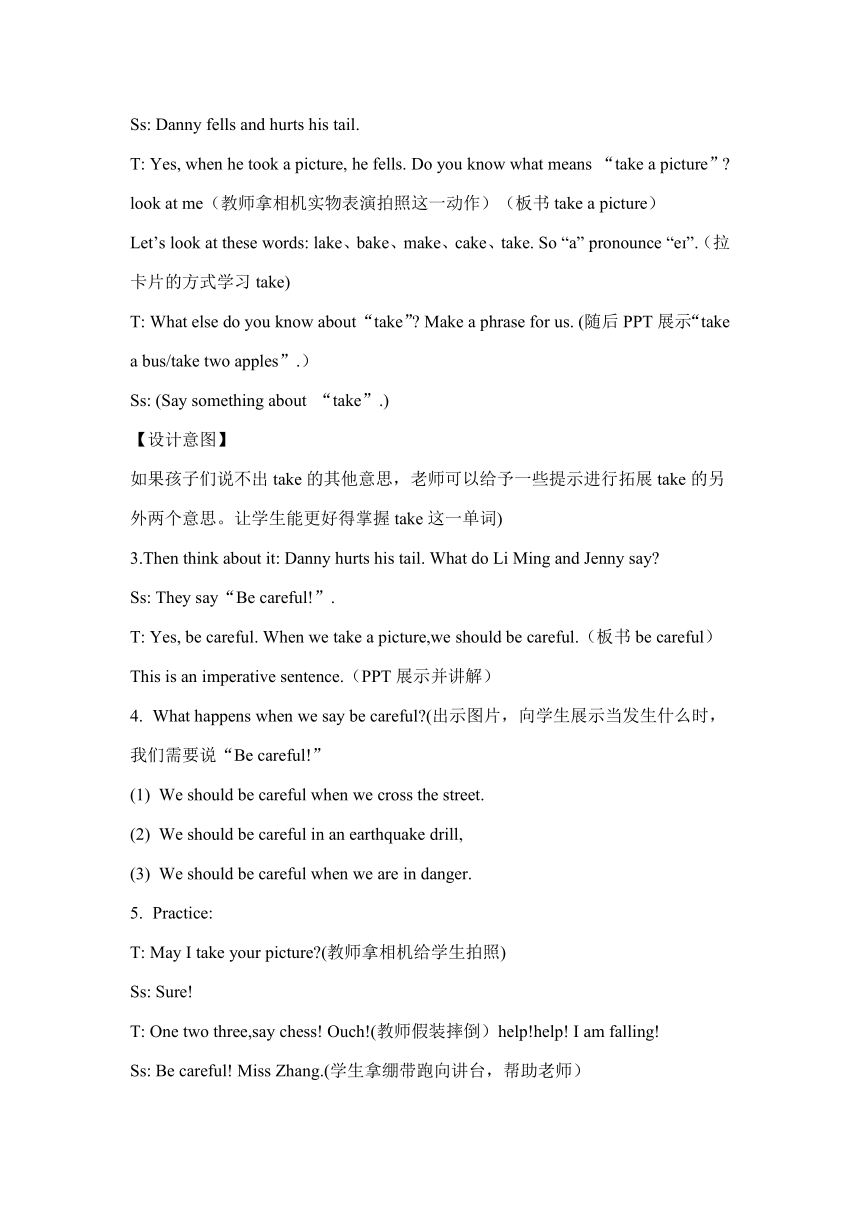Unit 2 In Beijing Lesson 9 The Palace Museum教学设计
文档属性
| 名称 | Unit 2 In Beijing Lesson 9 The Palace Museum教学设计 |  | |
| 格式 | docx | ||
| 文件大小 | 184.7KB | ||
| 资源类型 | 教案 | ||
| 版本资源 | 冀教版(三年级起点) | ||
| 科目 | 英语 | ||
| 更新时间 | 2024-06-12 14:31:17 | ||
图片预览




文档简介
冀教版《英语》(三年级起点)五年级下册
Lesson 9 The Palace Museum!教学设计
一、教学内容:Lesson 9 《The Palace Museum》
二、教学内容分析:本课是冀教版《英语》(三年级起点)五年级下册第2单元第9课的The Palace Museum。本单元的题目是“In Beijing”,讲授了“在北京”的话题。单元围绕着Jenny, Li Ming, Danny这三个小主人公在北京参观天安门、故宫、长城以及在北京购物等一系列有趣的生活情景展开,本单元在引导学生学习关于中国首都北京名胜古迹的词汇和短语,学生要掌握基本的旅游词汇;能够讨论应该做和不应该做的事情;辨识和理解重要的国际标识;可以就所观察到的身边事物进行对话;会点事物和饮品;能够谈论人们正在做的事情。 本课“The Palace Museum”是本单元内容其中一篇,讲述了Jenny, Li Ming, Danny参观故宫博物馆发生的事情。学生在学习的过程中,运用英语语言读懂文本、提高了阅读技能,更重要的是学生在学习如何描述故宫的过程中,体会到语言学习的乐趣,增强自信心和成就感。故宫博物院是我国古代宫殿建筑艺术的瑰宝,是中华民族伟大创造力的集中体现。学习它,有助于增强我们的民族自豪感。
三、学生对象分析:授课对象为五年级学生,学生心理比较成熟,语感基本形成,理解能力表达能力较强。所以本节课应充分调动学生的积极性,发挥学生的潜能,发散学生的思维。
四、教学目标:
(一)知识与技能目标:
1、学生能听懂、会说、认读并书写下列词汇:take,take a picture,be
2、学生能认读,理解并运用下列基本句型结构:
May I take your picture Sure!
Be careful!
3、学生能学会一首关于照相的歌曲。
(二)学习策略目标:
1、积极与同学合作,共同完成任务;
2、通过评价反思,发展自我调控策略;
3、养成听录音和跟读句子的习惯。
(三)情感态度目标:
1、提高学习英语的兴趣,乐于阅读。
2、增强孩子们对文物保护的意识。
五、教学重、难点:
(一)课文的理解、单词和短语的拼读以及记忆。
(二)用所学句型简单介绍故宫。
六、教学媒体:自制课件、头饰、照相机、故宫的介绍,导游帽和导游旗
七、教学过程:
(一)热身导学,激发兴趣
1.Greetings
T: Good morning,everyone!
Ss: Good morning,teacher!
T: Today I’m very happy to have a class with you. So, I have some presents for you. Do you want the presents
Ss:Yes.
2.Groups
T:Okay, today you are divided into two groups. We are the pink group,show me your hands. Oh yeah, nice to meet you. We are the green group. Hello! How are you I ‘m fine, too. Then let’s have a PK. OK If you are good in my class,you can get up,up. And the winner will get my presents. Okay
Ss: OK.
【设计意图】
简单的问候,小组比赛形式激发孩子的学习兴趣。
评价方案:教师评价:全班分为两组,根据课上的表现,教师适时给予口头评价和加分评价。实物评价方式是为表现好的那一组在小树上向上爬一节。最后评比哪一组爬得最高。
3.Iead-in (由短视频导入新授)
T: Look at the video. What can you see
Ss: I can see the Palace Museum、bing dun dun、xue rong rong...
(学生运用已有知识,大胆发言,表达自己看到的内容。)
T: What do you know about the Palace Museum
Ss: It’s old...
(学生运用已有知识,表达关于故宫自己所知道的。)
T: Do you want to know more about the Palace Museum
Ss: Yes!
T: Okay,me too! So today we are going to learn lesson 9: the Palace Museum. (板书题目) 学生齐读题目。
【设计意图】
开课时由视频引入新授,将生活与文本联系了本课的主题--故宫。激发学生学习兴趣,让学生在愉快的氛围中放松自己并把注意力转移到课堂上。
创设情景,主动参与
1.T: How’s the weather today
Ss: It’s sunny.
T:yeah, it’s sunny today.Li Ming, Jenny and Danny are visiting the Palace Museum. Now let’s go with them together. First, let’s listen to the text and tell me what happens to Danny
Ss: Danny fells and hurts his tail.
T: Yes, when he took a picture, he fells. Do you know what means “take a picture” look at me(教师拿相机实物表演拍照这一动作)(板书take a picture)
Let’s look at these words: lake、bake、make、cake、take. So “a” pronounce “e ”.(拉卡片的方式学习take)
T: What else do you know about “take” Make a phrase for us. (随后PPT展示“take a bus/take two apples”.)
Ss: (Say something about “take”.)
【设计意图】
如果孩子们说不出take的其他意思,老师可以给予一些提示进行拓展take的另外两个意思。让学生能更好得掌握take这一单词)
3.Then think about it: Danny hurts his tail. What do Li Ming and Jenny say
Ss: They say“Be careful!”.
T: Yes, be careful. When we take a picture,we should be careful.(板书be careful)This is an imperative sentence.(PPT展示并讲解)
What happens when we say be careful (出示图片,向学生展示当发生什么时,我们需要说“Be careful!”
We should be careful when we cross the street.
We should be careful in an earthquake drill,
We should be careful when we are in danger.
Practice:
T: May I take your picture (教师拿相机给学生拍照)
Ss: Sure!
T: One two three,say chess! Ouch!(教师假装摔倒)help!help! I am falling!
Ss: Be careful! Miss Zhang.(学生拿绷带跑向讲台,帮助老师)
Are you Okay
T:No, I hurt my finger.
Ss: Don’t worry,I can help you.
T: Thank you!
【设计意图】
教师与学生利用恰当的肢体语言动作来表演take a picture和be careful两个短语,这样不仅可以使学生加深对这两个短语的理解、记忆和应用。而且还能更好地表达师生之间的情感。从而加强师生之间的沟通,缩短师生之间的距离。
(三)以趣巩新,互动发展
1. Listen and talk.(播放录音,同桌两人合作进行问答.)
T: Now let’s listen and talk,ask and answer with your partner.
(1)T:How old is the Palace Museum
S1:It’s about six hundred years old. It’s old.(板书关键词)
S1:How old is the Palace Museum
Ss:It’s about six hundred years old. It’s old.
(2)S1:What colour is the palace
S2:The palace is red and yellow. It is beautiful. (板书关键词)
(3)S1:Are there old chairs and tables in the Palace Museum
S2:Yes,there are some old chairs and tables in the Palace Museum.(板书关键词)
(4)S1:Does Danny take a picture
S2:Yes,he does.
(5)Does Danny hurt his tail
S2:Yes,he does.
read and act.(4个人一组,分角色表演课文内容。)
T: Four students make a group, read and act.
3.Sing a song.
T: Do you like to sing songs Now let’s sing a song “Let’s take a picture, you and me.”
Ss: OK.
(1)老师带领学生做动作,take a picture,say cheese,make a funny face。
(2)放录音,学生站起来跟着老师边说边做。
【设计意图】
英文歌曲中的一些内容包含了本节课的所学内容,巩固了所学知识同时也促进学生学习的兴趣。课外延申,形成能力。
4.To be a guide.(用导游的身份介绍北京。)
学生们拿出自己提前做好的前参。(关于北京的资料)
T: If you are a guide, introduce Beijing to your partner
【设计意图】
语言的学习的最终目的是为了用,学生以导游的身份介绍故宫,既巩固了今天所学的知识,同时可以拓展关于故宫更多的介绍,达到学以致用。
(四)知识小结,整体掌握。
1.自然过渡,引出本课的情感目标,保护文物。
T: Today we know something about the Palace Museum. Do you like it Okay, we all like it, so we don’t destroy it. We should protect our cultural relic.Beijing is great,China is great!We love Beijing! We love China! We love our big country!
2.Summary
T: What did we learn about the Palace Museum today
Ss: ......
T: Who is the winner Clap your hands. Give you presents.(故宫的贺卡)
3. Homework
(1)Make a poster about the Palace Museum.(做一张关于故宫的海报)
(2)If you are a guide,how to Introduce Beijing to your partner,write down.(假如你是一名导游,怎样介绍北京)
【设计意图】
增强孩子们对文物保护的意识,激发为中华文化的悠久历史和博大精深而感到骄傲的民族自豪感。
八、板书设计
Lesson9: The Palace Museum教学反思
虽然这节课的主题是The Palace Museum 故宫,课文中并没有介绍故宫的各种历史,而是借书中主人公到故宫参观的经历,通过他们在故宫发生的故事为情境学习单词camera picture及句型May I take your picture I hurt my nose. Be careful!这节课整节课的气氛都很好,尤其是练习句型May I take your picture 时,学生们都积极参与。在学习课文时,孩子们能认真的去学习并提出自己不懂的地方,充分体现了学习的自主性。在播放Flash课件学习课文时,我发现孩子们都听得特别认真,他们带着我留给他们的问题去观看flash动画更有目的性,动画结束大多数学生都能回答问题。
课堂上我发现孩子们学习新单词不再像三四年级那样困难,似乎不需要太多机械操练的过程,也许是他们到了五年级有了一定词汇量和单词发音规律的积累,这对老师和学生来说都是好事,这样我们就有更多的时间用英语进行交流,而不是简单地机械重复。
Lesson 9 The Palace Museum!教学设计
一、教学内容:Lesson 9 《The Palace Museum》
二、教学内容分析:本课是冀教版《英语》(三年级起点)五年级下册第2单元第9课的The Palace Museum。本单元的题目是“In Beijing”,讲授了“在北京”的话题。单元围绕着Jenny, Li Ming, Danny这三个小主人公在北京参观天安门、故宫、长城以及在北京购物等一系列有趣的生活情景展开,本单元在引导学生学习关于中国首都北京名胜古迹的词汇和短语,学生要掌握基本的旅游词汇;能够讨论应该做和不应该做的事情;辨识和理解重要的国际标识;可以就所观察到的身边事物进行对话;会点事物和饮品;能够谈论人们正在做的事情。 本课“The Palace Museum”是本单元内容其中一篇,讲述了Jenny, Li Ming, Danny参观故宫博物馆发生的事情。学生在学习的过程中,运用英语语言读懂文本、提高了阅读技能,更重要的是学生在学习如何描述故宫的过程中,体会到语言学习的乐趣,增强自信心和成就感。故宫博物院是我国古代宫殿建筑艺术的瑰宝,是中华民族伟大创造力的集中体现。学习它,有助于增强我们的民族自豪感。
三、学生对象分析:授课对象为五年级学生,学生心理比较成熟,语感基本形成,理解能力表达能力较强。所以本节课应充分调动学生的积极性,发挥学生的潜能,发散学生的思维。
四、教学目标:
(一)知识与技能目标:
1、学生能听懂、会说、认读并书写下列词汇:take,take a picture,be
2、学生能认读,理解并运用下列基本句型结构:
May I take your picture Sure!
Be careful!
3、学生能学会一首关于照相的歌曲。
(二)学习策略目标:
1、积极与同学合作,共同完成任务;
2、通过评价反思,发展自我调控策略;
3、养成听录音和跟读句子的习惯。
(三)情感态度目标:
1、提高学习英语的兴趣,乐于阅读。
2、增强孩子们对文物保护的意识。
五、教学重、难点:
(一)课文的理解、单词和短语的拼读以及记忆。
(二)用所学句型简单介绍故宫。
六、教学媒体:自制课件、头饰、照相机、故宫的介绍,导游帽和导游旗
七、教学过程:
(一)热身导学,激发兴趣
1.Greetings
T: Good morning,everyone!
Ss: Good morning,teacher!
T: Today I’m very happy to have a class with you. So, I have some presents for you. Do you want the presents
Ss:Yes.
2.Groups
T:Okay, today you are divided into two groups. We are the pink group,show me your hands. Oh yeah, nice to meet you. We are the green group. Hello! How are you I ‘m fine, too. Then let’s have a PK. OK If you are good in my class,you can get up,up. And the winner will get my presents. Okay
Ss: OK.
【设计意图】
简单的问候,小组比赛形式激发孩子的学习兴趣。
评价方案:教师评价:全班分为两组,根据课上的表现,教师适时给予口头评价和加分评价。实物评价方式是为表现好的那一组在小树上向上爬一节。最后评比哪一组爬得最高。
3.Iead-in (由短视频导入新授)
T: Look at the video. What can you see
Ss: I can see the Palace Museum、bing dun dun、xue rong rong...
(学生运用已有知识,大胆发言,表达自己看到的内容。)
T: What do you know about the Palace Museum
Ss: It’s old...
(学生运用已有知识,表达关于故宫自己所知道的。)
T: Do you want to know more about the Palace Museum
Ss: Yes!
T: Okay,me too! So today we are going to learn lesson 9: the Palace Museum. (板书题目) 学生齐读题目。
【设计意图】
开课时由视频引入新授,将生活与文本联系了本课的主题--故宫。激发学生学习兴趣,让学生在愉快的氛围中放松自己并把注意力转移到课堂上。
创设情景,主动参与
1.T: How’s the weather today
Ss: It’s sunny.
T:yeah, it’s sunny today.Li Ming, Jenny and Danny are visiting the Palace Museum. Now let’s go with them together. First, let’s listen to the text and tell me what happens to Danny
Ss: Danny fells and hurts his tail.
T: Yes, when he took a picture, he fells. Do you know what means “take a picture” look at me(教师拿相机实物表演拍照这一动作)(板书take a picture)
Let’s look at these words: lake、bake、make、cake、take. So “a” pronounce “e ”.(拉卡片的方式学习take)
T: What else do you know about “take” Make a phrase for us. (随后PPT展示“take a bus/take two apples”.)
Ss: (Say something about “take”.)
【设计意图】
如果孩子们说不出take的其他意思,老师可以给予一些提示进行拓展take的另外两个意思。让学生能更好得掌握take这一单词)
3.Then think about it: Danny hurts his tail. What do Li Ming and Jenny say
Ss: They say“Be careful!”.
T: Yes, be careful. When we take a picture,we should be careful.(板书be careful)This is an imperative sentence.(PPT展示并讲解)
What happens when we say be careful (出示图片,向学生展示当发生什么时,我们需要说“Be careful!”
We should be careful when we cross the street.
We should be careful in an earthquake drill,
We should be careful when we are in danger.
Practice:
T: May I take your picture (教师拿相机给学生拍照)
Ss: Sure!
T: One two three,say chess! Ouch!(教师假装摔倒)help!help! I am falling!
Ss: Be careful! Miss Zhang.(学生拿绷带跑向讲台,帮助老师)
Are you Okay
T:No, I hurt my finger.
Ss: Don’t worry,I can help you.
T: Thank you!
【设计意图】
教师与学生利用恰当的肢体语言动作来表演take a picture和be careful两个短语,这样不仅可以使学生加深对这两个短语的理解、记忆和应用。而且还能更好地表达师生之间的情感。从而加强师生之间的沟通,缩短师生之间的距离。
(三)以趣巩新,互动发展
1. Listen and talk.(播放录音,同桌两人合作进行问答.)
T: Now let’s listen and talk,ask and answer with your partner.
(1)T:How old is the Palace Museum
S1:It’s about six hundred years old. It’s old.(板书关键词)
S1:How old is the Palace Museum
Ss:It’s about six hundred years old. It’s old.
(2)S1:What colour is the palace
S2:The palace is red and yellow. It is beautiful. (板书关键词)
(3)S1:Are there old chairs and tables in the Palace Museum
S2:Yes,there are some old chairs and tables in the Palace Museum.(板书关键词)
(4)S1:Does Danny take a picture
S2:Yes,he does.
(5)Does Danny hurt his tail
S2:Yes,he does.
read and act.(4个人一组,分角色表演课文内容。)
T: Four students make a group, read and act.
3.Sing a song.
T: Do you like to sing songs Now let’s sing a song “Let’s take a picture, you and me.”
Ss: OK.
(1)老师带领学生做动作,take a picture,say cheese,make a funny face。
(2)放录音,学生站起来跟着老师边说边做。
【设计意图】
英文歌曲中的一些内容包含了本节课的所学内容,巩固了所学知识同时也促进学生学习的兴趣。课外延申,形成能力。
4.To be a guide.(用导游的身份介绍北京。)
学生们拿出自己提前做好的前参。(关于北京的资料)
T: If you are a guide, introduce Beijing to your partner
【设计意图】
语言的学习的最终目的是为了用,学生以导游的身份介绍故宫,既巩固了今天所学的知识,同时可以拓展关于故宫更多的介绍,达到学以致用。
(四)知识小结,整体掌握。
1.自然过渡,引出本课的情感目标,保护文物。
T: Today we know something about the Palace Museum. Do you like it Okay, we all like it, so we don’t destroy it. We should protect our cultural relic.Beijing is great,China is great!We love Beijing! We love China! We love our big country!
2.Summary
T: What did we learn about the Palace Museum today
Ss: ......
T: Who is the winner Clap your hands. Give you presents.(故宫的贺卡)
3. Homework
(1)Make a poster about the Palace Museum.(做一张关于故宫的海报)
(2)If you are a guide,how to Introduce Beijing to your partner,write down.(假如你是一名导游,怎样介绍北京)
【设计意图】
增强孩子们对文物保护的意识,激发为中华文化的悠久历史和博大精深而感到骄傲的民族自豪感。
八、板书设计
Lesson9: The Palace Museum教学反思
虽然这节课的主题是The Palace Museum 故宫,课文中并没有介绍故宫的各种历史,而是借书中主人公到故宫参观的经历,通过他们在故宫发生的故事为情境学习单词camera picture及句型May I take your picture I hurt my nose. Be careful!这节课整节课的气氛都很好,尤其是练习句型May I take your picture 时,学生们都积极参与。在学习课文时,孩子们能认真的去学习并提出自己不懂的地方,充分体现了学习的自主性。在播放Flash课件学习课文时,我发现孩子们都听得特别认真,他们带着我留给他们的问题去观看flash动画更有目的性,动画结束大多数学生都能回答问题。
课堂上我发现孩子们学习新单词不再像三四年级那样困难,似乎不需要太多机械操练的过程,也许是他们到了五年级有了一定词汇量和单词发音规律的积累,这对老师和学生来说都是好事,这样我们就有更多的时间用英语进行交流,而不是简单地机械重复。
同课章节目录
- Unit 1 Going to Beijing
- Lesson 1 I Am Excited!
- Lesson 2 What Are You Doing?
- Lesson 3 Who Is Singing?
- Lesson 4 Who Is Hungry?
- Lesson 5 What Are They Doing?
- Lesson 6 Danny Is Lost!
- Again, Please!
- Unit 2 In Beijing
- Lesson 7 Arriving in Beijing
- Lesson 8 Tian'anmem Square
- Lesson 9 The Palace Museum
- Lesson 10 The Great Wall
- Lesson 11 Shopping in Beijing
- Lesson 12 A Visit to the Great Wall
- Again, Please!
- Unit 3 Writing Home
- Lesson 13 Let's Buy Postcards!
- Lesson 14 Jenny Writes a Postcard
- Lesson 15 Sending the Postcards
- Lesson 16 An Email Is Fast
- Lesson 17 Danny's Email
- Lesson 18 Little Zeke Sends an Email
- Unit 4 Did You Have a Nice Trip?
- Lesson 19 Li Ming Goes Home
- Lesson 20 Jenny Goes Home
- Lesson 21 Look at the Photos!
- Lesson 22 Gifts for Everyone
- Lesson 23 An Email from Li Ming
- Lesson 24 A Gift for Little Zeke
